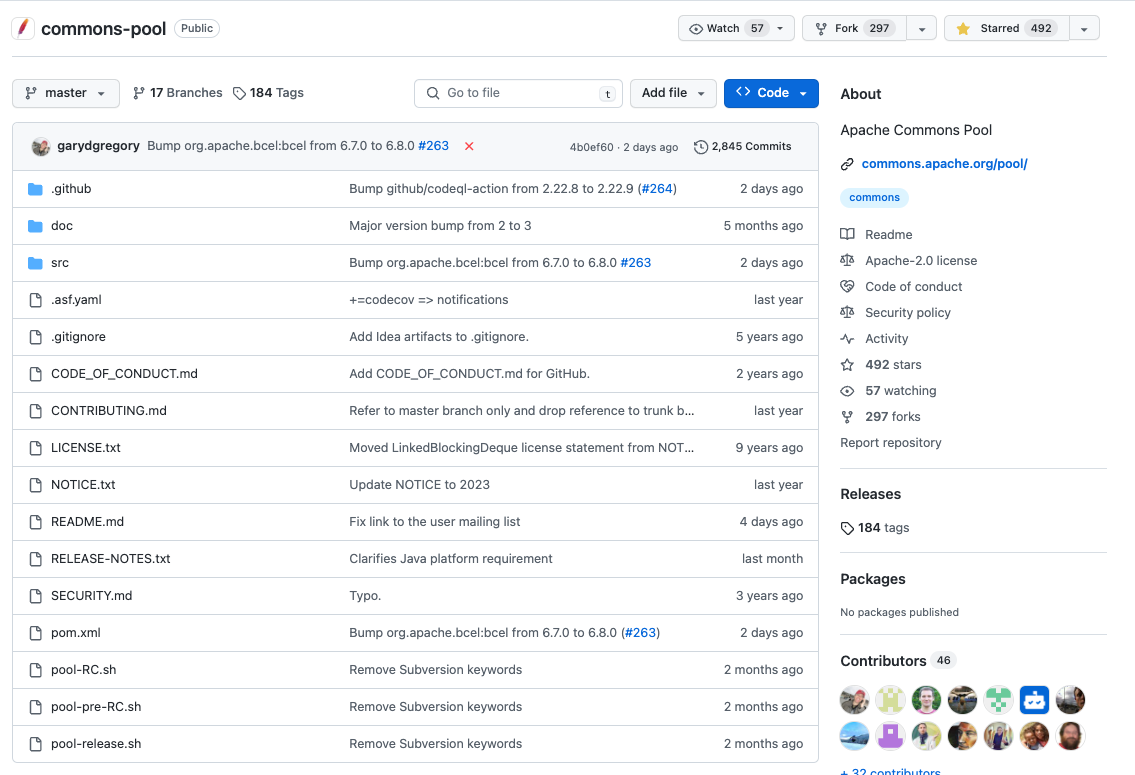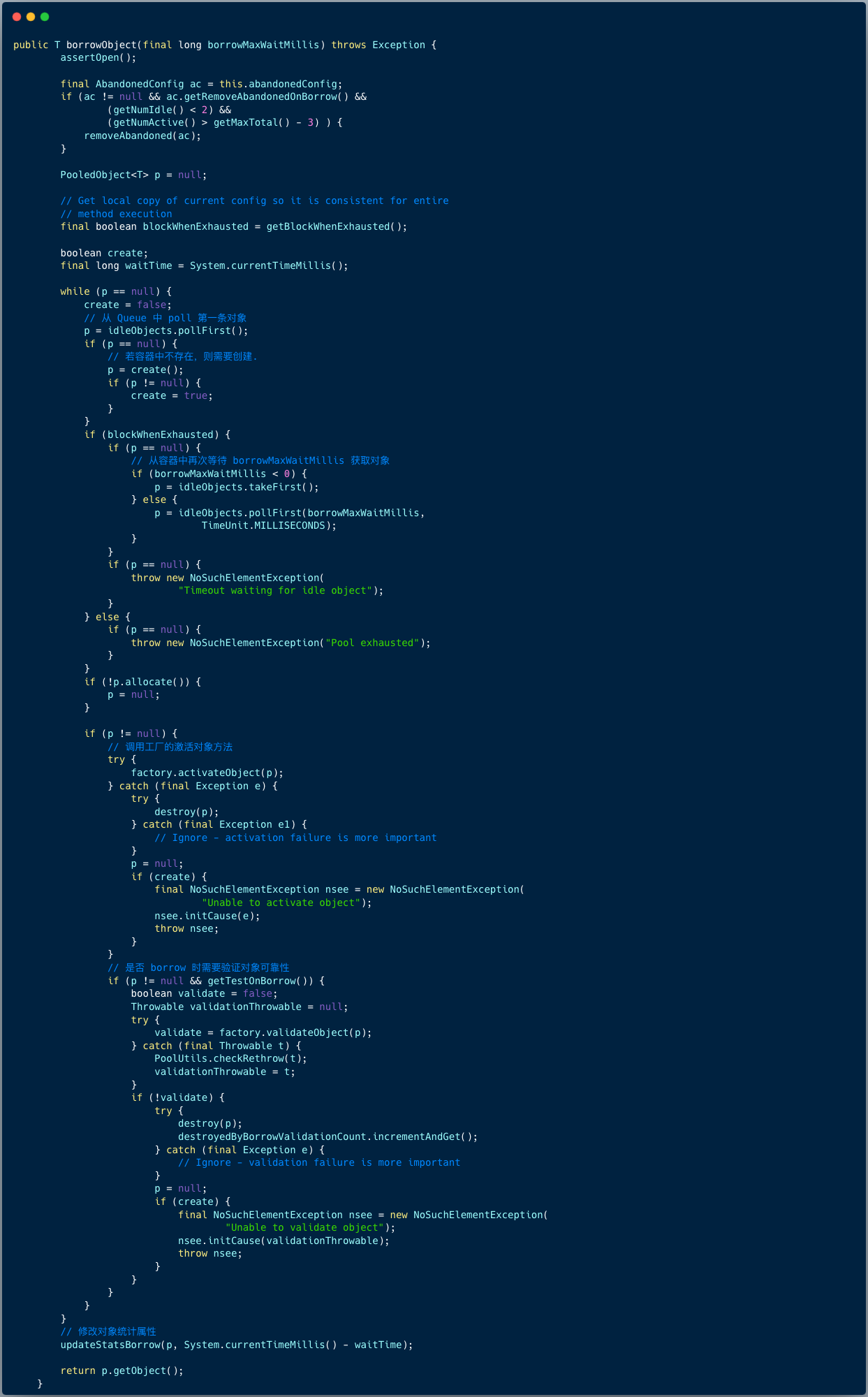对象池化框架Commons Pool 2
Apache Commons Pool 提供了通用对象池的实现,用于管理和复用对象,以提高系统的性能和资源利用率。
对象池是一种设计模式,它维护一组已经创建的对象,并在需要时将其提供给应用程序,而不是每次需要时都创建新的对象。

1 基础用法
1.1 添加依赖
<dependency>
<groupId>org.apache.commons</groupId>
<artifactId>commons-pool2</artifactId>
<version>2.0</version>
</dependency>
1.2 定义对象工厂
PooledObjectFactory 是一个池化对象工厂接口,定义了生成对象、激活对象、钝化对象、销毁对象的方法,如下:
public interface PooledObjectFactory<T> {
/**
* Creates an instance that can be served by the pool and wrap it in a
*/
PooledObject<T> makeObject() throws Exception;
/**
* Destroys an instance no longer needed by the pool
*/
void destroyObject(PooledObject<T> p) throws Exception;
/**
* Ensures that the instance is safe to be returned by the pool
*/
boolean validateObject(PooledObject<T> p);
/**
* Reinitializes an instance to be returned by the pool
*/
void activateObject(PooledObject<T> p) throws Exception;
/**
* Uninitializes an instance to be returned to the idle object pool
*/
void passivateObject(PooledObject<T> p) throws Exception;
}
以下是一个简单的示例:
- 定义需要池化的对象 MyObject
public class MyObject {
private String uid = UUID.randomUUID().toString();
private volatile boolean valid = true;
public void initialize() {
System.out.println("初始化对象" + uid);
valid = true;
}
public void destroy() {
System.out.println("销毁对象" + uid);
valid = false;
}
public boolean isValid() {
return valid;
}
public String getUid() {
return uid;
}
}
- 定义对象工厂
public class MyObjectFactory implements PooledObjectFactory<MyObject> {
@Override
public PooledObject<MyObject> makeObject() throws Exception {
// 创建一个新对象
MyObject object = new MyObject();
// 初始化对象
object.initialize();
return new DefaultPooledObject<>(object);
}
@Override
public void destroyObject(PooledObject<MyObject> p) throws Exception {
// 销毁对象
p.getObject().destroy();
}
@Override
public boolean validateObject(PooledObject<MyObject> p) {
return p.getObject().isValid();
}
@Override
public void activateObject(PooledObject<MyObject> p) throws Exception {
}
@Override
public void passivateObject(PooledObject<MyObject> p) throws Exception {
}
}
1.3 配置对象池
创建 GenericObjectPool 对象,并设置相关参数,如最大对象数量、最小空闲对象数量等。
GenericObjectPoolConfig config = new GenericObjectPoolConfig();
config.setMaxTotal(20);
config.setMaxIdle(5);
config.setTestWhileIdle(true);
config.setMinEvictableIdleTimeMillis(60000L);
GenericObjectPool<MyObject> pool = new GenericObjectPool<>(new MyObjectFactory(), config);
1.4 借用和归还对象
MyObject myObject = null;
try {
myObject = pool.borrowObject();
System.out.println("get对象" + myObject.getUid() + " thread:" + Thread.*currentThread*().getName());
} catch (Exception e) {
e.printStackTrace();
} finally {
try {
if (myObject != null) {
pool.returnObject(myObject);
}
} catch (Exception e) {
e.printStackTrace();
}
}
2 Jedis 连接池
Jedis 是一个 Java 语言的 Redis 客户端库。它提供了一组易于使用的 API,可以用来连接和操作 Redis 数据库。
它的内部使用 Commons Pool 来管理 Redis 连接 ,我们使用 jedis 3.3.0 版本写一个简单的示例。
public class JedisMain {
public static void main(String[] args) throws Exception{
// 创建连接池配置
JedisPoolConfig config = new JedisPoolConfig();
config.setMaxTotal(100);
config.setMaxIdle(20);
// 创建连接池
JedisPool pool = new JedisPool(config, "localhost", 6379);
// 获取连接
Jedis jedis = pool.getResource();
jedis.set("hello" , "张勇");
// 使用连接
String value = jedis.get("hello");
System.out.println(value);
// 归还连接
jedis.close();
// 关闭连接池
// pool.close();
Thread.sleep(5000);
}
}
如下图,JedisFactory 实现了对象工厂,实现了创建对象、销毁对象、验证对象、激活对象四个方法。

比如验证对象方法,逻辑是调用 Jedis 的 ping 方法,判断该连接是否存活。
3 原理解析
我们重点解析 GenericObjectPool 类的原理。
3.1 初始化
public GenericObjectPool(
final PooledObjectFactory<T> factory,
final GenericObjectPoolConfig<T> config) {
super(config, ONAME_BASE, config.getJmxNamePrefix());
if (factory == null) {
jmxUnregister(); // tidy up
throw new IllegalArgumentException("factory may not be null");
}
this.factory = factory;
idleObjects = new LinkedBlockingDeque<>(config.getFairness());
setConfig(config);
}
private final Map<IdentityWrapper<T>, PooledObject<T>> allObjects =
new ConcurrentHashMap<>();
初始化做两件事情:
初始化 JedisFactory 工厂对象。
对象容器 idleObjects , 类型是 LinkedBlockingDeque 。
因此存储容器有两个,所有的对象 allObjects 和空闲对象 idleObjects (可以直接取出使用)。
配置对象池属性 。
3.2 创建对象
我们关注 GenericObjectPool 类的 borrowObject 方法。

逻辑其实很简单 :
从容器中获取第一个条目对象,若没有获取,则调用工厂对象的创建对象方法,并将该对象加入到全局对象 Map。
创建成功后,调用对象的激活方法,接着验证对象的可靠性,最后将对象返回。
3.3 归还连接

流程如下:
- 判断返还对象时是否校验,假如校验失败,则销毁该对象,将该对象从存储容器中删除 ;
- 调用工厂对象的激活对象方法 ;
- 若空闲对象 Map 元素大小达到最大值,则销毁该对象,将该对象从存储容器中删除 ;
- 正常将对象放回到空闲对象容器 idleObjects 。
参考资料:
https://github.com/redis/jedis/wiki/Getting-started
https://github.com/apache/commons-pool
如果我的文章对你有所帮助,还请帮忙点赞、在看、转发一下,你的支持会激励我输出更高质量的文章,非常感谢!

